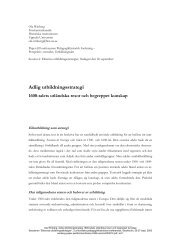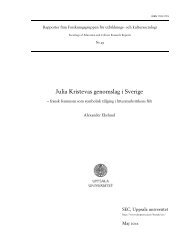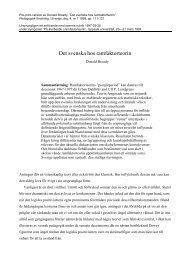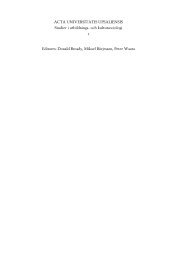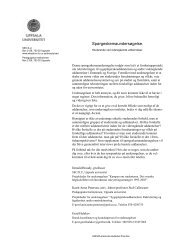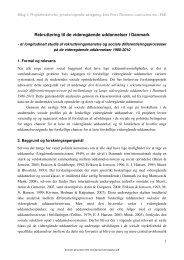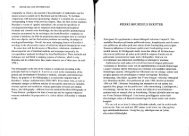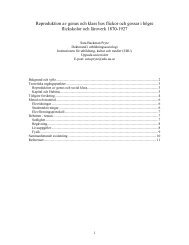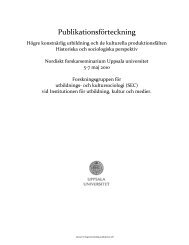exploring uses of digital archives in research and ... - skeptron.uu.se
exploring uses of digital archives in research and ... - skeptron.uu.se
exploring uses of digital archives in research and ... - skeptron.uu.se
You also want an ePaper? Increase the reach of your titles
YUMPU automatically turns print PDFs into web optimized ePapers that Google loves.
communities. However, the rapidly grow<strong>in</strong>g <strong>in</strong>formation on the Web <strong>and</strong> <strong>in</strong>tranets ca<strong>u<strong>se</strong>s</strong>problems when <strong>se</strong>arch<strong>in</strong>g for <strong>and</strong> access<strong>in</strong>g <strong>in</strong>formation. Likewi<strong>se</strong>, the same problemoccurs when <strong>in</strong>dividuals are try<strong>in</strong>g to organize <strong>and</strong> share resources 6 . One problem with thegrow<strong>in</strong>g <strong>digital</strong> <strong>archives</strong> is that content <strong>of</strong>ten is moulded <strong>in</strong>to proprietary <strong>and</strong> applicationdependant formats <strong>and</strong> therefore difficult to retrieve, access <strong>and</strong> reu<strong>se</strong> <strong>in</strong> any other contextthan that <strong>in</strong> the one <strong>in</strong> which they are produced.Ten years ago, <strong>in</strong>dividual <strong>re<strong>se</strong>arch</strong>ers, <strong>re<strong>se</strong>arch</strong> groups <strong>and</strong> archivists typically u<strong>se</strong>dproprietary non - portable formats for their depositories <strong>of</strong> <strong>digital</strong>ized sources, for example<strong>in</strong> the humanities electronic versions <strong>of</strong> pr<strong>in</strong>ted texts, transcribed manuscripts or languagecorpora. Today there are de facto encod<strong>in</strong>g 7 st<strong>and</strong>ards, such as the TEI DTD (the TextEncod<strong>in</strong>g Initiative Document Type Def<strong>in</strong>ition) 8 with<strong>in</strong> the humanities, which permitsscholars to create, u<strong>se</strong> <strong>and</strong> share collections <strong>of</strong> well structured high quality <strong>digital</strong> sources.The same k<strong>in</strong>d <strong>of</strong> development has taken place with<strong>in</strong> most scholarly doma<strong>in</strong>s, as well as<strong>in</strong> many <strong>in</strong>dustries but not <strong>in</strong> the same extent <strong>in</strong> the teach<strong>in</strong>g practices <strong>in</strong> higher education.This means that the educational milieus are lagg<strong>in</strong>g beh<strong>in</strong>d the <strong>re<strong>se</strong>arch</strong> communities.However, most teachers <strong>and</strong> students do not take part <strong>in</strong> this development. They are stillreferred to pr<strong>in</strong>ted material, poorly structured HTML pages or non–reusable PDF files. Thequalified <strong>digital</strong> sources they encounter are more <strong>of</strong>ten than not only available onproprietary systems <strong>and</strong> formats that may function well as long as the material stays on theweb site or on the CD-ROM. Students <strong>and</strong> teachers meet with problems as soon as they tryto <strong>in</strong>corporate material <strong>in</strong>to their learn<strong>in</strong>g environment, for example <strong>in</strong> order to accomplishprojects or to create tailor–built cour<strong>se</strong>ware. Cour<strong>se</strong> content is, thus, not sufficiently<strong>in</strong>tegrated <strong>in</strong>to the learn<strong>in</strong>g environment. 9Why then, deschool<strong>in</strong>g <strong>in</strong>formation? When Ivan Illich launched his campaign 30 years agoaga<strong>in</strong>st the school<strong>in</strong>g <strong>of</strong> society, the educational system was the first <strong>in</strong> a row <strong>of</strong> <strong>se</strong>veralattacks (titled accord<strong>in</strong>gly) on the augmented pr<strong>of</strong>essionalism <strong>and</strong> the top–downmanagement <strong>of</strong> schools mak<strong>in</strong>g students powerless <strong>and</strong> therefore prevents people fromlearn<strong>in</strong>g. Illich propo<strong>se</strong>d the need to replace schools with libraries as the natural arena forlearn<strong>in</strong>g to expo<strong>se</strong> the authoritarian hidden curriculum <strong>of</strong> education. 10 The idea that schoolscould be replaced by networks <strong>of</strong> <strong>in</strong>formation propo<strong>se</strong>d by Illich I th<strong>in</strong>k is relevant <strong>in</strong> somerespects especially <strong>in</strong> terms <strong>of</strong> what k<strong>in</strong>d <strong>of</strong> opportunities it might br<strong>in</strong>g for educationalpractices. Firstly becau<strong>se</strong> the flows <strong>of</strong> <strong>in</strong>formation have become easier to reach e.g. by <strong>u<strong>se</strong>s</strong><strong>of</strong> <strong>in</strong>formation technology <strong>and</strong> <strong>se</strong>condly becau<strong>se</strong> greater possibilities for both producers<strong>and</strong> u<strong>se</strong>rs to manipulate <strong>and</strong> u<strong>se</strong> the content <strong>of</strong> <strong>in</strong>formation. Indeed, that may be part whatIvan Illich was look<strong>in</strong>g for when he wrote <strong>in</strong> Deschool<strong>in</strong>g Society <strong>and</strong> as part <strong>of</strong> hisproposal <strong>of</strong> learn<strong>in</strong>g webs, Illich thought <strong>of</strong> ways to “[...] provide the learner with new6 What is a resource? It might consist <strong>of</strong> almost any k<strong>in</strong>d <strong>of</strong> repre<strong>se</strong>ntation <strong>and</strong> a <strong>digital</strong> resource is any objector location that has a unique identifier <strong>and</strong> can be <strong>digital</strong>ly stored, acces<strong>se</strong>d <strong>and</strong> distributed via a global/localarea network. A resource could be e.g. web pages, cour<strong>se</strong> modules, lecture notes, reports, papers, <strong>digital</strong><strong>archives</strong>, a record <strong>in</strong> databa<strong>se</strong> or a student <strong>digital</strong> portfolio.7 The purpo<strong>se</strong> <strong>of</strong> encod<strong>in</strong>g a text or other k<strong>in</strong>ds <strong>of</strong> data is to provide <strong>in</strong>formation <strong>in</strong> order to add some k<strong>in</strong>d <strong>of</strong>functionality such as assist<strong>in</strong>g a computer programs to perform actions on that text. A common k<strong>in</strong>d <strong>of</strong>simple encod<strong>in</strong>g is HTML which allows the web brow<strong>se</strong>r to display a given resource such as a text withoutshow<strong>in</strong>g the actual encod<strong>in</strong>g i.e. the tags.8 The guidel<strong>in</strong>es from the consortium TEI (Text Encod<strong>in</strong>g Initiative) are the dom<strong>in</strong>at<strong>in</strong>g de facto-st<strong>and</strong>ard forencod<strong>in</strong>g textual resources such as <strong>digital</strong> critical editions <strong>of</strong> literary <strong>and</strong> historical sources. Seehttp://www.tei-c.org/9 The<strong>se</strong> issues have been pre<strong>se</strong>nted <strong>and</strong> discus<strong>se</strong>d by Broady <strong>in</strong> “Det nya h<strong>and</strong>biblioteket” (1995), “Contentdesign. Methods <strong>and</strong> tools for the creation <strong>of</strong> portable hypermedia <strong>archives</strong>” (1997 ) <strong>and</strong> “Digitala arkiv ochportföljer” (2001) but also to some extent by other, for example Julia Fl<strong>and</strong>ers <strong>in</strong> her article “Learn<strong>in</strong>g,Read<strong>in</strong>g, <strong>and</strong> the Problem <strong>of</strong> Scale: Us<strong>in</strong>g Woman Writers Onl<strong>in</strong>e.” (2002).10 See Illich <strong>in</strong> “Deschool<strong>in</strong>g Society” (1971a) but also Illich, 1970 <strong>and</strong> 1971b.pm-030505.doc utkast avh.pm. Monica Langerth Zetterman 3(34)



